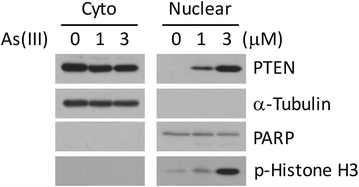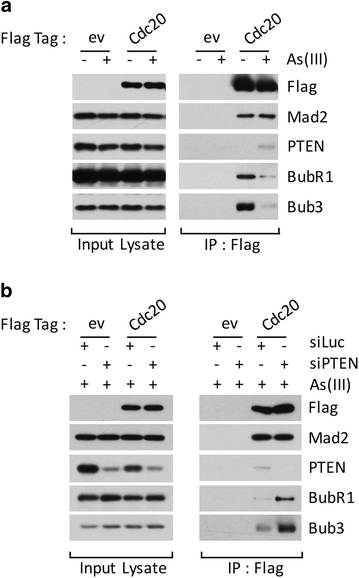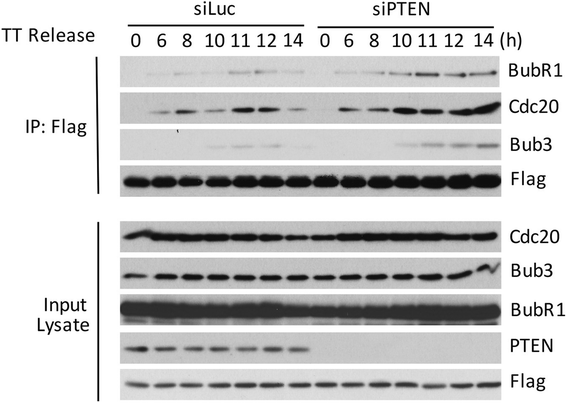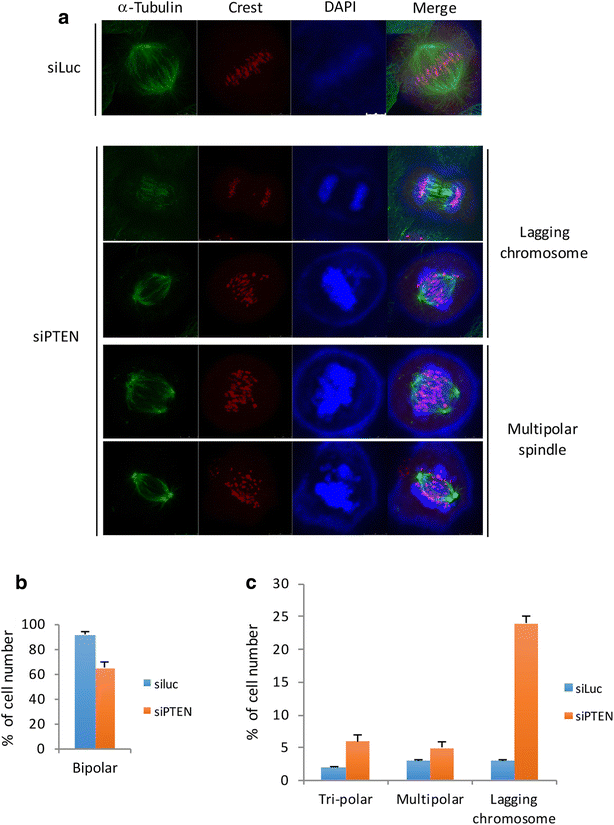PTEN is a negative regulator of mitotic checkpoint complex during the cell cycle
- PMID: 28670501
- PMCID: PMC5492438
- DOI: 10.1186/s40164-017-0079-0
PTEN is a negative regulator of mitotic checkpoint complex during the cell cycle
Abstract
Nuclear PTEN plays an important role during mitosis. To understand the molecular basis by which PTEN mediates mitotic progression, we examined whether PTEN regulated the formation of mitotic checkpoint complex (MCC). We observed that arsenic trioxide, a mitotic inducer, stimulated nuclear translocation of PTEN in a time-dependent manner. PTEN physically interacted with Cdc20 and Mad2, two important components of MCC. Arsenic treatment diminished the physical association of PTEN with BubR1 and Bub3 but not with Cdc20 and Mad2. Our further studies revealed that downregulation of PTEN via RNAi enhanced formation of MCC during the cell cycle. Moreover, PTEN silencing induced chromosomal instability. Given the crucial role of PTEN in suppressing tumor development, our study strongly suggests that PTEN also functions to maintain chromosomal stability, partly through suppressing unscheduled formation of MCC.
Keywords: Chromosomes; Mitosis; Mitotic checkpoint complex; Nuclear localization; PTEN.
Figures




Similar articles
-
Role of ubiquitylation of components of mitotic checkpoint complex in their dissociation from anaphase-promoting complex/cyclosome.Proc Natl Acad Sci U S A. 2018 Feb 20;115(8):1777-1782. doi: 10.1073/pnas.1720312115. Epub 2018 Feb 5. Proc Natl Acad Sci U S A. 2018. PMID: 29432156 Free PMC article.
-
Bub1 and aurora B cooperate to maintain BubR1-mediated inhibition of APC/CCdc20.J Cell Sci. 2005 Aug 15;118(Pt 16):3639-52. doi: 10.1242/jcs.02487. Epub 2005 Jul 26. J Cell Sci. 2005. PMID: 16046481
-
Intermediates in the assembly of mitotic checkpoint complexes and their role in the regulation of the anaphase-promoting complex.Proc Natl Acad Sci U S A. 2016 Jan 26;113(4):966-71. doi: 10.1073/pnas.1524551113. Epub 2016 Jan 11. Proc Natl Acad Sci U S A. 2016. PMID: 26755599 Free PMC article.
-
The mitotic checkpoint: a signaling pathway that allows a single unattached kinetochore to inhibit mitotic exit.Prog Cell Cycle Res. 2003;5:431-9. Prog Cell Cycle Res. 2003. PMID: 14593737 Review.
-
MAD1: Kinetochore Receptors and Catalytic Mechanisms.Front Cell Dev Biol. 2018 May 7;6:51. doi: 10.3389/fcell.2018.00051. eCollection 2018. Front Cell Dev Biol. 2018. PMID: 29868582 Free PMC article. Review.
Cited by
-
CBX8 interacts with chromatin PTEN and is involved in regulating mitotic progression.Cell Prolif. 2021 Nov;54(11):e13110. doi: 10.1111/cpr.13110. Epub 2021 Sep 30. Cell Prolif. 2021. Retraction in: Cell Prolif. 2025 Aug;58(8):e70083. doi: 10.1111/cpr.70083. PMID: 34592789 Free PMC article. Retracted.
-
LGN loss randomizes spindle orientation and accelerates tumorigenesis in PTEN-deficient epidermis.Mol Biol Cell. 2024 Feb 1;35(2):br5. doi: 10.1091/mbc.E23-03-0111. Epub 2023 Nov 22. Mol Biol Cell. 2024. PMID: 37991903 Free PMC article.
-
Novel insights in cell cycle dysregulation during prostate cancer progression.Endocr Relat Cancer. 2021 May 11;28(6):R141-R155. doi: 10.1530/ERC-20-0517. Endocr Relat Cancer. 2021. PMID: 33830069 Free PMC article. Review.
-
Long non-coding RNAs in esophageal cancer: molecular mechanisms, functions, and potential applications.J Hematol Oncol. 2018 Sep 17;11(1):118. doi: 10.1186/s13045-018-0663-8. J Hematol Oncol. 2018. PMID: 30223861 Free PMC article. Review.
-
CFI-402257, a TTK inhibitor, effectively suppresses hepatocellular carcinoma.Proc Natl Acad Sci U S A. 2022 Aug 9;119(32):e2119514119. doi: 10.1073/pnas.2119514119. Epub 2022 Aug 1. Proc Natl Acad Sci U S A. 2022. PMID: 35914158 Free PMC article.
References
-
- Shen ZX, et al. Use of arsenic trioxide (As2O3) in the treatment of acute promyelocytic leukemia (APL): II. Clinical efficacy and pharmacokinetics in relapsed patients. Blood. 1997;89(9):3354–3360. - PubMed
-
- Chen GQ, et al. Use of arsenic trioxide (As2O3) in the treatment of acute promyelocytic leukemia (APL): I. As2O3 exerts dose-dependent dual effects on APL cells. Blood. 1997;89(9):3345–3353. - PubMed
LinkOut - more resources
Full Text Sources
Other Literature Sources
Research Materials
Miscellaneous

